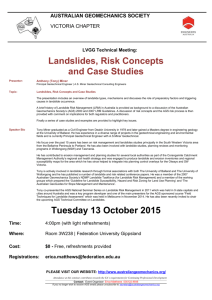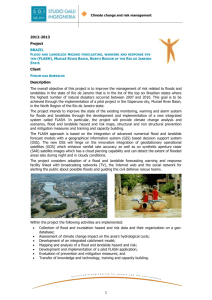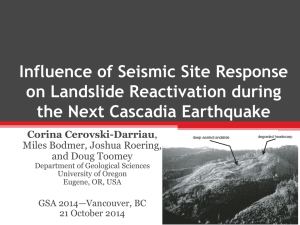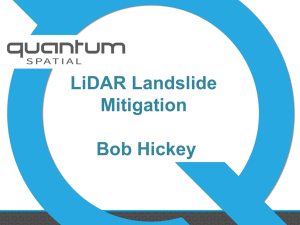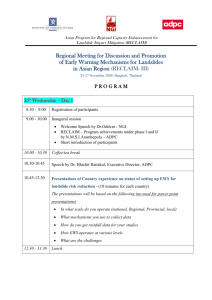Process Models - The University of Maine
advertisement
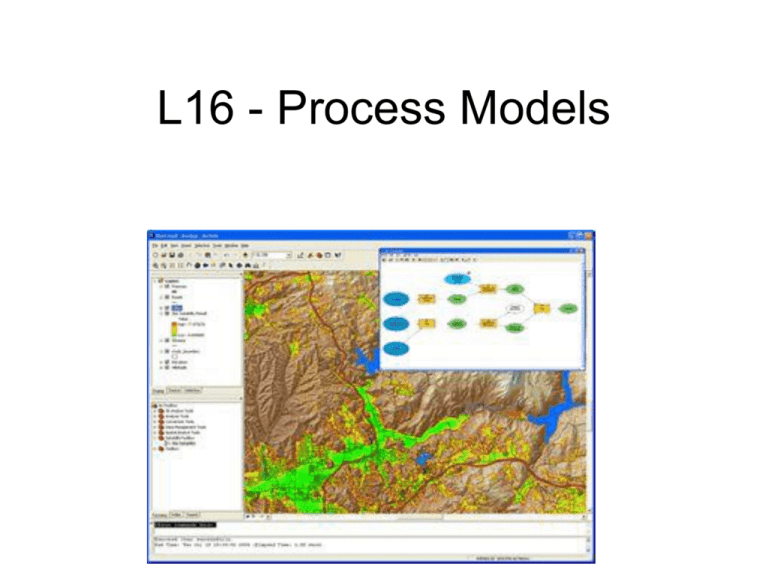
L16 - Process Models Quick Review of Data Models Two major data models – Vector • Simple vector data structure • Higher level data models – TIN – Dynamic segmentation – Regions – Raster (grid and image) Representation Models • Represent the objects of real world through a sets of layers (Data Models) • Common data models/descriptive models. • Spatial relationships within an object (the shape of a building). • Between the other objects in the landscape (the distribution of buildings). • Model the attributes of the objects (who owns each building). Process Models • Describe the interaction or processes of the objects of real world, which are modeled in the representation model, by using map calculation • • • • Suitability modeling: where should I put it? Distance modeling: how far is it? Hydrologic modeling: where will the water flow to? Surface modeling: what is the pollution level? Why construct a process model? • We need to make decisions, and take actions about spatial phenomenon. • It may help us evaluate our understanding of complex processes. What type of model should we construct? Classification Schemes: – Before (a priori) vs after (a posteriori) the fact. – Natural and scale analog models • Natural analog models uses real world objects or events as the basis for the model. • Scale analog models – Mathematical models • Deterministic • Stochastic may be either steady state or dynamic • Optimization methods – Conceptual models Mathematical Models • Static vs. dynamic: A dynamic model accounts for timedependent changes in the state of the system, while a static (or steady-state) model calculates the system in equilibrium, and thus is time-invariant. Dynamic models typically are represented by differential equations. • Deterministic vs. stochastic: A deterministic model is one in which every set of variable states is uniquely determined by parameters in the model and by sets of previous states of these variables. Therefore, deterministic models perform the same way for a given set of initial conditions. Conversely, in a stochastic model, randomness is present, and variable states are not described by unique values, but rather by probability distributions. Mathematical Models • Optimization Model: A model used to find the best possible choice out of a set of alternatives. It may use the mathematical expression of a problem to maximize or minimize some function. The alternatives are frequently restricted by constraints on the values of the variables. A simple example might be finding the most efficient transport pattern to carry commodities from the point of supply to the markets, given the volumes of production and demand, together with unit transport costs. Global Mathematical Functions Polynomial Trend Surface Global Mathematical Functions Kriged Surface Creating a conceptual model to solve a spatial problem (1) • Step 1. Stating the problem. – What is the goal? • Step 2. Breaking the problem down. – What are the objectives. – What are the objects and their interactions (process model). – What datasets (data model and presentation model) will be needed Creating a conceptual model to solve a spatial problem (2) • Step 3. Exploring the datasets – What is contained in the datasets – what relationships between the datasets • Step 4. Performing analysis (spatial analysis) – Which tools to run the process models and build a overall model • Step 5. Verifying the model’s result – Does any thing in the model need to be changed? – If yes, go back to step 4 • Step 6. Implementing the result Example using conceptual model to create a suitability map Step 1. Stating the problem Step 2. Breaking the problem down Process models Datasets (data models & representation model) • Step 3. Exploring the datasets Datasets (data models & representation model) Step 4. Performing analysis (spatial analysis) Step 5. Verifying the model’s result • to verify if the result is correct Step 6. Implementing the result • to building a new school in the chosen location Process Modeling and GIS • GIS uses: – Natural and scale analog – Conceptual and – Mathematical modeling • Either in isolation or combined in an iterative process. • Proprietary GIS software provides few if any process models as part of the standard set of functions – ArcGIS has Model Builder Modeling Physical and Environmental Processes • The following example comes from the Department of Conservation: Bureau of Geology, Natural Areas and Coastal Resources • http://www.maine.gov/doc/nrimc/mgs/expl ore/hazards/landslide/facts/nov10.htm Modeling Physical and Environmental Processes Figure 1. A clay bluff on the north shore of Rockland Harbor failed in 1996. This landslide formed a new scarp about 200 feet landward of the original top of the bluff in just a few hours. Two homes were destroyed as a result of this catastrophic slide. Figure 4. A large rotational slide occurred in the spring of 2006 along Hobbs Brook in Cumberland, Maine in an area of high relief and steeply sloped stream bank. The slide occurred after a heavy sustained rainfall. Figure 5. In May of 2005 a landslide occurred in Wells along the banks of the Merriland River. The slide destroyed a portion of a walking trail in the Rachel Carson National Wildlife Refuge and removed the backyard of a nearby house. Parts of the house's foundation were left exposed and the house was declared unsafe to inhabit. Figure 6. In May of 2006, a large earth flow caused by improper drainage due to recent road construction occurred in Sanford, Maine. The drainage focused heavy runoff towards this property, which then undercut the overlying sand, causing a large earth flow into Branch Brook. Figure 7. A landslide occurred along the Penobscot River in the town of Greenbush on June 30, 2006. The slide undercut Route 2 and caused this section of roadway to be closed until the river bank stabilized, and the roadway section was rebuilt. Risk Factor Analysis • The Landslide Susceptibility Maps were created using Risk Factor Analysis based on the following principles: – It is likely that landslides will occur where they have occurred in the past. – Landslides are likely to occur in similar geological, geomorphological, and hydrological conditions as they have in the past. • Simply put: – All available data is collected for risk factors that are located within the area of study. – Next, all landslide locations within this same area are systematically mapped. – Using a Geographic Information System (GIS), mapped landslides are compared to each risk factor and examined to determine which risk factors are the most statistically significant causes of landslides. – Once the analysis is complete, statistically significant risk factors are mapped, and zones of landslide susceptibility are created, ranging from areas of no risk factors (lowest landslide potential) to areas where there are 3 or more risk factors present (highest landslide potential). Landslide Risk Factors Risk Factors Used in This Study • Geomorphic Risk Factors – Slope: The steeper the slope, the larger the shear stress on the materials and the more susceptible the slope is to failure – Curvature (concave): Concave topography will concentrate groundwater flow, raising pore pressures and reducing shear strength of the soil. – Slope aspect: Repeated freeze/thaw cycles reduce the shear strength of the shallow soil material, increasing the likelihood of shallow soil slumps and creep. – Relief/slope height: As the thickness of the potential landslide block increases, the shear stress on the lower section of block increases, making the block (slope) more susceptible to failure. Therefore, thicker sections of surficial materials will be more susceptible to landslides. • Soil properties – Surficial geologic materials: Cohesive materials such as clays are prone to landslides along planes of weakness in the sediment. Less cohesive materials (sands) may slump if slopes oversteepen or ground water pore pressure increases and reduces internal friction. Figure 8 Figure 9 Figure 10 Figure 11 Figure 12 Figure 13 Figure 14 Figure 15 Figure 16 Figure 17 Limitations of the maps • Town-level landslide mapping is required to validate the susceptibility maps and provide credibility to local and State officials. • Landslide susceptibility maps indicate where landslides are likely to occur, not whether or when a landslide will occur. • The maps are based on landslide sites mapped below the glacial marine limit. Extension to other geologic settings would require additional study. – 18% of landslides occur on glacial till • Additional statistical analysis and incorporation of additional risk factors may improve the usefulness of the susceptibility maps. Data for additional risk factors must be available throughout the study area. Applicability of the maps • The maps identify where landslides have already occurred and where future landslides may occur. • Public education. • The effects of future landslides may be mitigated by adopting appropriate building codes or land use policies in landslide prone areas. Conclusions • Utilizing input and reviews of maps from local and state officials will enhance future map products. • Acquisition of LIDAR data will enhance quality and accuracy of maps. • Updating Maine's landslide inventory database will increase the accuracy and utilization of the maps. • Landslide susceptibility mapping is an ongoing process and will continually evolve into a more useful tool for landslide hazard mitigation. Modeling Human Processes • It is difficult to model humans spatial behavior. – How do people move through space when constrained by roads, buildings, fences, etc.? – How do people choose where to live, shop, vacation? Spatial Interaction Models • An abstract, idealized, representation of any and all kinds of spatial interaction phenomenon. • It is the flow of products, people, services, or information among places, in response to localized supply and demand. • These models describe the flows between a set of origin and destination zones on a map. • These are commercial models outside of most GIS packages. Three interdependent conditions are necessary for a spatial interaction to occur: – Complementarity. There must be a supply and a demand between the interacting locations; e.g., a store and its customers. – Intervening opportunity. There must not be another location that may offer a better alternative as a point of origin or as a point of destination. For instance, in order to have an interaction of a customer to a store, there must not be a closer store that offers a similar array of goods. – Transferability. Freight, persons or information being transferred must be supported by transport infrastructures, implying that the origin and the destination must be linked. Inputs and Outputs Origin Totals Destination Totals Interzonal Costs Spatial Interaction Model (an equation) Predicted Trips Beta Deterrence Parameter Origin/Destination Matrix http://people.hofstra.edu/geotrans/ eng/methods/odmatrix.html The Relationship between Distance and Interaction The above figure portrays a classic non-linear relationship between distance and the level of interactions of location A with other locations (B, C and D). It assumes that each location has the same complementarity level and that no intervening opportunities are present. The closest location, B, has the highest level of interaction with location A, while locations C and D have lower levels of interaction since they are located further away. http://people.hofstra.edu/geotrans/ eng/methods/distancedecay.html Three Basic Interaction Models http://people.hofstra.edu/geotrans/ eng/methods/threebasicmodels.ht Three Basic Interaction Models 1. Gravity model. The level of interaction between two locations is measured by multiplying their attributes, which is then pondered by their level of separation. Separation is often squared to reflect the growing friction of distance. On the above figure, two locations (i and j) have a respective "weight" (importance) of 35 and 20 and are at a distance (degree of separation) of 8. The resulting interaction is 10.9, which is reciprocal. http://people.hofstra.edu/geotrans/ eng/methods/threebasicmodels.ht Three Basic Interaction Models 2. Potential model. The level of interaction between one location and all the others is measured by the summation of the attributes of each other location pondered by their level of separation (again squared to reflect the friction of distance). On the above figure, the potential interaction of location i (Ti) is measured by adding the ratio "weight" / squared distance for each other locations (j, k and l). The potential interaction is 3.8, which is not reciprocal. http://people.hofstra.edu/geotrans/ eng/methods/threebasicmodels.ht Three Basic Interaction Models 3. Retail model. This model deals with boundaries, instead of interactions. It assumes that the market boundary between two locations is a function of their separation pondered by the ratio of their respective weights. If two locations have the same importance, their market boundary would be halfway between. On the above figure, the market boundary between locations i and j (Bij) is at a distance of 4.9 from i (and consequently at a distance of 2.1 from j). http://people.hofstra.edu/geotrans/ eng/methods/threebasicmodels.ht Conventional Models Are: – Over 25 years old. – Reflect a data poor era. – Non-linear but only in a simple way. – Designed to minimize computation. – Possibly poor performer. Neural Networks • Make use of AI. • Uses data to learn (or discover) patterns and relationships instead of relying totally on people to specify them. • It offers equation free modeling. • It is highly automated modeling. • It has universal modeling capabilities • It is noisy data resistant. Modeling the Decision Making Process • Outputs from process models are the raw information required for making decisions. • Map overlay is the traditional method for spatial decision making, however this can be problematic: – Overlay can be difficult to understand if multiple factors are involved. – Some GIS packages do not allow different weights for the variables. – Threshold values, important for polygon overlay, may be based on opinion. The Solution • Use Multi-Criteria Evaluation (MCE) Techniques. • This allows map layers to be weighted, based on importance. • This also has problems: – Different algorithms produce slightly different results. – The specification of weights is also based on opinion.


